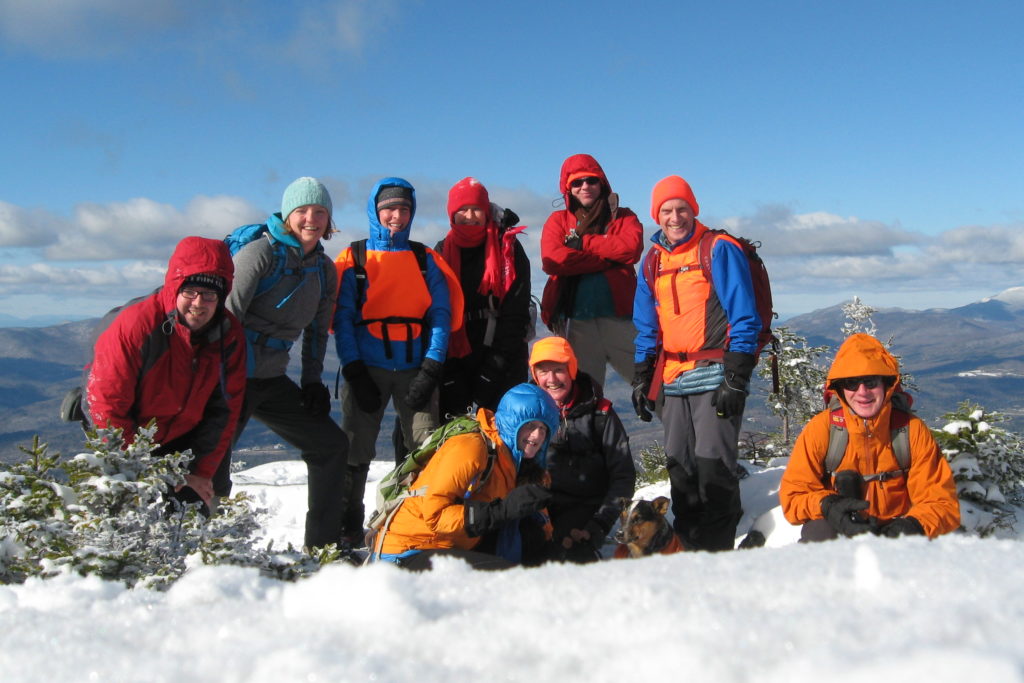
Organized hiking in groups — such as with a school group, scouting group, or outing club — is an amazing way to see the Long Trail. This page is intended to provide your group with the logistics to have a safe and enjoyable trip. If you are here to notify GMC of your group outing, please visit our Group Notification Calendar to sign up your trip. For group hiking questions, concerns, or for help with itineraries, please contact the Group Outreach and Field Coordinator at [email protected].
Guidelines for Overnight Groups
- Contact the GMC ahead of time and use the Group Notification Calendar.
- Overnight group size should be limited to 10 people including leaders.
- For alpine summits and designated wilderness areas, please limit day hike group size to 10 people including leaders.
- Always plan to tent near shelters and leave shelters open for individual hikers (except at Taft Lodge).
- Only stay at designated group overnight sites.
- Plan to contact the appropriate agency for permit applications at least 30 days ahead of your trip.
- Always follow Leave No Trace principles.
Guidelines for Day Hiking Groups
- Contact the GMC ahead of time for assistance with planning your hike.
- We encourage all day hiking groups of 10 or more to split into multiple different hiking parties which operate separately from the other party. By leaving from the trailhead at different times, not gathering during lunch or snack breaks and operating as separate groups your reduce your impact on the natural environment.
- The maximum group size for a day hike is 20 people unless you are visiting an alpine zone, fragile shoreline or designated wilderness area where the maximum group size is 10 people.
- On the summits of Mt. Mansfield, Camel’s Hump and Mt. Abraham, the maximum group size is always 10 people including leaders.
- Plan to contact the appropriate agency for permit applications at least 30 days ahead of your trip.
- Always follow Leave No Trace principles.
Permit Info
If you’re taking a group hiking on the Long Trail or Appalachian Trail in Vermont, chances are that your group will need a permit. Permit requirements differ depending on whether you are hiking in the Green Mountain National Forest or on VT state land. If you will be hiking between the Massachusetts border and Mt. Ellen (except Cooper Lodge), or between Route 4 and the New Hampshire border on the Appalachian Trail, you will be in the Green Mountain National Forest. If you will be hiking between Mt. Ellen and the Canadian border, or staying at Cooper Lodge, you will be on VT state land. Permits allow both agencies to be sure that the land is seeing intended use and, more importantly, to provide educational resources for hiking groups such as information about Leave No Trace. For both agencies, please submit your permit application at least 30 days prior to the start of your trip.
You will need a permit from the Green Mountain National Forest if any of the below apply for your trip:
- Charging more than the cost of basic trip expenses (i.e. food, travel, etc).
- Paying the trip leaders (includes trip leaders that are doing the trip as part of their normal salaries such as teachers, camp counselors, or non-profits).
- Providing equipment for a fee as part of the trip.
- Collecting plants, animals, historical artifacts, or other items.
- The trip is for a commercial endeavor (photo shoot, movie filming, etc).
- You have more than 75 people in your group.
You do not need a GMNF permit if you are covering basic costs and are entirely volunteer (such as a scout troop). Permits are required regardless of trip length.
Green Mountain National Forest Special Use Permits
You will need a permit from VT Department of Forests, Parks and Recreation if any of the below apply for your trip:
- The group is organized and/or publicized (regardless of if fees are being charged or not).
- The group is larger than 10 people.
- It’s an activity or event where a fee is being charged.
- Trip leaders are being paid (just like for the GMNF) or gear is being rented at a fee.
- You will be collecting plants, animals, historical artifacts, or other items..
You may still need a Vermont state permit even if you are just covering the basic cost of the trip (like a scout troop) however, the office may be able to waive the application fee. For help, you can contact the District Office of the area that you will be hiking in or you can email the Outreach and Field Coordinator.
Vermont Forest, Parks & Recreation Special Use Permit
Bears and Food Storage
Secure food storage is required on all areas of the Long Trail System. Black bears are active in all areas of Vermont and are a concern at overnight sites on the Long Trail System. A proper bear hang is very challenging in the high-elevation forests of the Long Trail System, and we highly encourage all group users to invest in secure food storage systems.
Depending on availability, the Green Mountain Club’s Bear Canister Lending Program may have bear canisters for free rental. Visit Bear Canister Lending Program for more information.
For information on bear boxes, ursacks, bear hangs and bear safety on the Long Trail, visit GMC’s Wildlife page.
Get Involved
The Green Mountain Club offers multiple programs to strengthen your group’s Long Trail experience. We offer free Leave No Trace workshops to groups, which allow organized group members to gain a deeper understanding of the principles that guide responsible outdoor ethics. We can meet your hiking group in the backcountry during your trip or schedule an Leave No Trace workshop for trip leaders in advance of your hike. These workshops are meaningful to all hikers and GMC’s Leave No Trace Master Educators can cover a wide range of topics. The GMC also offers Wilderness First Aid, Map and Compass, Winter Trekking, Vermont ecology, and more!
The Green Mountain Club’s Service Learning program works with businesses, summer camps, scout troops, college orientation programs and many other organized groups to complete construction and maintenance projects on the Long Trail. Volunteering for the Green Mountain Club through a Group Service trip is a great way to give back to the Long Trail while also engaging the community of your office, scout troop or school in a healthy, productive, and generous way.
Group Sites
Please Note: Not all Long Trail overnight sites can handle the impact from group use. This is due to many factors, some of which are: no tenting near the shelter (with the exception of Taft Lodge, which can fit groups in the lodge), a small pit-style privy, or high elevation (which causes fragile vegetation to grow back much more slowly). You can find a list of all the LT/AT overnight sites available to groups on our Group Notification Calendar. Below is a list of Forest Service Campgrounds and State Parks near the trail which are suitable for large overnight groups. For help planning an itinerary on the Long Trail System, please contact the Group Outreach & Field Coordinator.
| Green Mountain National Forest Campgrounds | Capacity | Fee |
| GMNF Red Mill Campground | 100+ | yes |
| GMNF Grout Pond Campground | 100+ | yes |
| GMNF Hapgood Pond Campground | 100+ | yes |
| USFS Primitive Campsite 1 mile east of Big Branch Shelter on USFS Road #10 | 100+ | yes |
| GMNF Chittenden Brook Campground | 100+ | yes |
| USFS Primitive Campsite at Sucker Brook Trailhead | 10 | no |
| USFS Primitive Campsite at Skylight Pond Trailhead | 10 | no |
| USFS Primitive Campsite at Clark Brook Trailhead | 20 | no |
| USFS Primitive Campsite at Cooley Glen Trailhead | 10 | no |
Please visit Recreation on the Green Mountain National Forest for more information on these campsites.
| VT Dept. of Forests, Parks & Recreation Campgrounds | Capacity | Fee |
| Woodford State Park Campground | 100+ | yes |
| Emerald Lake State Park | 100+ | yes |
| Gifford Woods State Park | 100+ | yes |
| Little River State Park Campground | 100+ | yes |
| Underhill State Park | 100+ | yes |
| Smuggler’s Notch State Park | 100+ | yes |
| Elmore State Park Campground | 100+ | yes |
| Silver Lake State Park Campground | 100+ | yes |
Please visit Vermont State Parks for more information on these campsites.
Frequently Asked Questions:
How do I know I am hiking in a group?
The GMC’s Group Outreach Program was created to help manage organized group use on the Long Trail/Appalachian Trail in Vermont. Organized groups that use the Long Trail include: camps, colleges, scouts, schools, guiding services, or any other formal, pre-organized group. However, even if you set out on your hike and are informally traveling with 6 or more people, you are technically considered a group. Groups exert a disproportionate impact on water quality, alpine vegetation, wildlife habitat, trail treadway, backcountry campsites, and the experiences of other hikers. Whether you are part of an organized group or an informal gathering of friends, when hiking as a group please take extra care to follow Leave No Trace principles. You can always contact the Outreach and Field Coordinator to find out more about group hiking guidelines, permitting, and more.
Do I need a permit to bring my group out on the Long Trail?
For the most part, if you are an organized hiking group (college, boy scouts, camp, etc) and/or any sort of monetary exchange happens for the purpose of the hike (leaders are being paid, gear is rented at a fee, etc.) a permit will be required. Permits and permit requirements are different depending on whether you are hiking in the Green Mountain National Forest or on Vermont State land.
Are there size limits for groups hiking?
Yes. On overnight trips please limit group size to 10 people, including leaders. On day hikes, please limit to 20 people including leaders, unless your group will be visiting a designated wilderness area or sensitive alpine summit. When traveling in either of those sensitive areas, please limit your group to 10 people including leaders. These group limits are set in place to help minimize the environmental impact of group use on overnight sites and the trail, along with helping to preserve the backcountry experience of other hikers.
Can my large group split up and hike separately during the day and then meet up for the night at a shelter?
Having a large group reconvene at an overnight site “cancels out” the environmental benefits of having the group split up and hike separately during the day. A large group that has been split into smaller groups of 6-10 should plan to have each smaller group camp at separate overnight sites. Similarly, large groups that split up should also avoid reuniting on the trail for a break or lunch.
On an extended trip, how many miles a day should my group plan to travel?
The distance your group should cover or is able to cover in a day is dependent on a number of factors including: the group members’ physical fitness, each individual’s experience in the backcountry, whether they have the proper gear, the terrain you will cover, weather conditions, etc. Talk to your group to determine everyone’s goals for the trip and each individual’s hiking experience. Plan your itinerary accordingly, research the terrain of the planned route, and have a backup plan in case your group does not cover the planned distance.
Are there any fees for staying at overnight sites?
As of the 2023 hiking season, all overnight sites on the Long Trail System are free to stay overnight (previously there was a $5 fee at some sites). Some high-use sites and those in fragile environments have a paid caretaker and now operate on a donation-based model. Caretakers are maintained at: Stratton Pond, Griffith Lake, Little Rock Pond, Battell Shelter (no groups), Montclair Glen (no groups), Hump Brook Tent Site, Butler Lodge (no groups), Taft Lodge, and the Sterling Pond area. To make a donation on behalf of your group, please do so here.
What happens if there’s an emergency while my group is hiking?
Although emergencies on the trail are rare, backcountry emergencies present a special set of difficulties. Many parts of the Long Trail are remote, consist of relatively rough terrain, and lack cellular telephone reception; all making definitive care often many hours away. When planning your group’s itinerary make sure you have some emergency alternative routes, such as side trails, and the closest hospitals on file with you. It is also highly encouraged that group leaders and anyone else interested take a wilderness medicine course such as Wilderness First Aid. More information on course offerings can be found at soloschools.com. Search and Rescues in Vermont are through the state police. If you do have an emergency, always call 911.
Can my group stay in shelters or should we plan to tent?
Everyone traveling along the Long Trail/Appalachian Trail in Vermont should carry shelter, such as a tent, since space in shelters is not guaranteed. Groups should plan to camp in designated group tenting areas near shelters to free up shelter space for people hiking individually. However, groups should always be conscious of their impact on the site at which they are staying. Please use pre-established campsites or sites that are already clearly impacted. Avoid tenting in areas that are just beginning to show use.
How should my group properly dispose of waste while on the Long Trail?
We encourage a “carry in, carry out” policy. If you bring trash or food waste into the backcountry, please carry it out with you to dispose of properly. Along the Long Trail/Appalachian Trail in Vermont, human waste is managed by different types of privies (outhouses) at each overnight site. Please leave only human waste and toilet paper in the privies. Food waste, personal hygiene products, wet naps, and food wrappers do not decompose. If trash is found in the privy it must be packed out by someone else. To learn more about the different methods of backcountry waste management, please contact the GMC at (802) 244-7037 or email [email protected]. If you are at a staffed overnight site you can always ask the Caretaker!
If you are not near a privy and nature calls, bury your waste at least 6 inches deep in a cat hole and make your cat hole 200 feet from trails, campsites, and water sources.
Where on the Long Trail should I plan my route if I want the most solitude, scenic views, group overnight sites, etc?
We would be more than happy to help you plan your group’s itinerary and we encourage leaders to send us itineraries they have already planned. To plan group-specific itineraries or send one in, please contact the GMC’s Outreach and Field Coordinator. Keep in mind as well that some time periods are busier than others on the trail. On holidays, weekends, and during nice weather, popular spots are often more crowded than during the week or during poor weather.


















